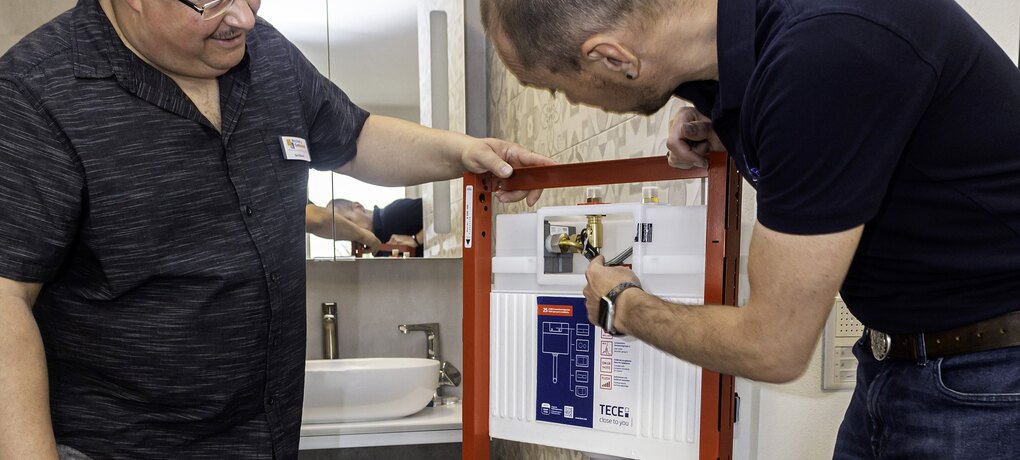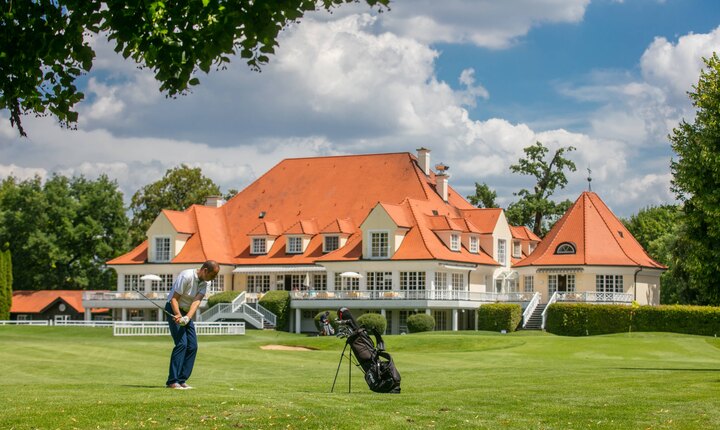
The charm of simplicity: documented potable water hygiene in the golf club hotel with hygiene flushing integrated in the toilet
The Wittelsbach Golf Club in Neuburg an der Donau enjoys an excellent reputation not only among golf enthusiasts, but also among overnight guests who come not only for the sport but also for the outstanding cuisine. During a complete modernisation of the bathrooms in the 20-room guest house, potable water hygiene was one of the topics on the agenda of the planning and construction meeting. Instead of an extensive series or ring line installation with combined flushing units, Gerd Bischof, a building services contractor, advised a decentralised solution that significantly simplifies the construction work involved – managing to persuade the architect and operator in the process.
The hotel industry has to pay special attention to the issue of potable water hygiene, as there are always cases of Legionella pneumophila, often referred to as Legionnaires' disease, the cause of which can be traced back to potable water systems in hotels, among other things. If not used over a period of time, the potable water stagnates in the pipes and germs multiply. Since 2011, it has therefore been mandatory to test large systems with more than 400 litres in the potable water heater or systems with more than three litres of water in the pipe network up to the tap.
Hotels in particular sometimes find it challenging to meet the requirements of the Drinking Water Ordinance. One reason is vacant rooms: especially in unoccupied rooms or out of season, the potable water network is rarely flushed sufficiently through water consumption. This ultimately poses the risk of strong legionella growth, which can spread through the pipe network.
The Wittelsbach Golf Club with a 20-room guest house and a restaurant for up to 180 people stands on traditional ground: where once the horses of the Bavarian electors and kings were bred, today golf balls are teed off and holed in the Danube meadows in a park-like setting. A demanding clientele relaxes here for sporting and culinary pleasures in dignified surroundings, while at the same time trusting in the safety of the building’s technical systems.

Easy solution: flushing at the end of each pipe section
The Drinking Water Ordinance (TrinkwV) and the standards situation require the drinking water system to be operated "as intended". This means, in particular, that regular consumption at all taps and hence the exchange of water in the pipe network must be ensured. If there is no consumption by the user over a period of time, the operator must ensure that the water is exchanged either manually or automatically. For centralised solutions, several pipes are flushed and the rooms must be looped into a ring or series line, which entails considerable installation work, especially with renovations. However, if a bacterial incident were to occur, the entire pipe network would be affected because the contaminated flush flow passes through everywhere.
Gerd Bischof, a contractor, favoured a solution from TECE, the domestic technology specialist from Münsterland, because it was less complicated. He was impressed by the simplicity of the principle, because the hygiene flushing unit is housed in the cistern, which has to be replaced anyway when the bathroom is renovated. To put it simply: the toilet is installed as the last consumer in a line. The integrated flushing unit releases water at regular intervals via a flushing programme to prevent water stagnation in the pipe. The only installation work required here is that an additional power line and hot water have to be routed further to the cistern. Gerd Bischof: “With just one metre of additional pipe, I save myself and my customer from having to drag pipes through the whole building.” The flushed water simply disappears into the toilet. The electronics in the flushing unit document the regular flushing processes, which can be called up via the app and exported in PDF format.
Gerd Bischof convinced Munich architect Franz Lassak with his proposed solution. The experienced architect is also familiar with hotel construction and is well aware of the problems of potable water hygiene. He says about Gerd Bischof: “He explained it well and I trust his expertise. We need a solution in the hotel that runs on its own and that we don't have to deal with much.” Ultimately, the architect must also take into account the need to create legal certainty in the client's hotel operations: “Simple, safe and comprehensible solutions always work for me, because they also work in everyday use.” Incidentally, the appearance is another persuasive factor: the flushing unit integrated in the cistern doesn’t require an additional unaesthetic inspection opening - for maintenance work, it can be reached by dismantling the toilet flush plate.

Straightforward installation and legally compliant documentation
Compared to previous solutions with separate flushing stations, the solution from TECE integrated in the cistern also impresses from a cost perspective. The difference: with separate flush stations, more installation work and material input is required, but with the hygiene cistern from TECE, this is minimal. The decisive factor for the TECE solution for Gerd Bischof was the fact that: “The hygiene flush in the toilet is easy to plan, easy to install – and I don't need the manufacturer's customer service department for commissioning, we just do it ourselves. As a result, I've got the hygiene flush under control from the start right through to everyday operation.”
Golf club operator Korbinian Kofler was pleased with how the architect and contractor collaborated: “The trust of our guests is sacred to us. This technology ensures that we can provide our guests with optimal potable, bathing and shower water without any effort and with the clearest conscience.” And on top of that there is no extra work involved for his staff – everything is fully automated.
Here you can find more information about our hygiene flush:
The integrated hygiene flush by TECE

